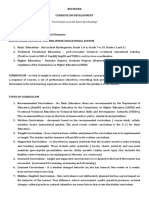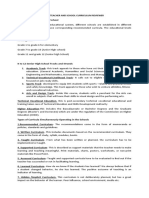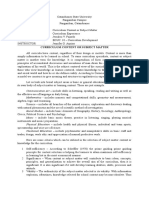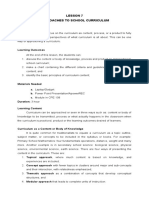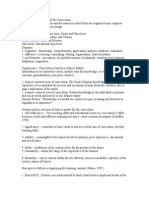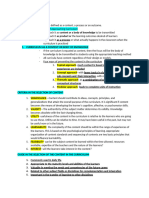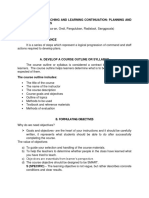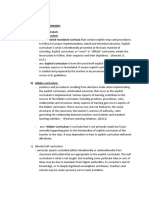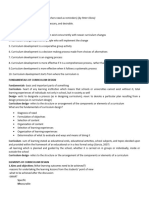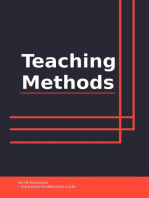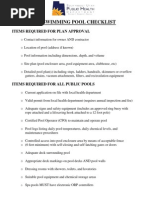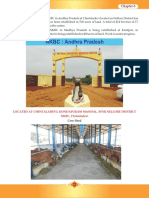0 ratings0% found this document useful (0 votes)
8 viewsCurriculum Development For Teachers Summary - 20240729 - 162527 - 0000
Curriculum Development For Teachers Summary - 20240729 - 162527 - 0000
Uploaded by
Michelle Batayola TenioCopyright:
© All Rights Reserved
Available Formats
Download as PDF, TXT or read online from Scribd
Curriculum Development For Teachers Summary - 20240729 - 162527 - 0000
Curriculum Development For Teachers Summary - 20240729 - 162527 - 0000
Uploaded by
Michelle Batayola Tenio0 ratings0% found this document useful (0 votes)
8 views3 pagesOriginal Title
Curriculum Development for Teachers Summary_20240729_162527_0000
Copyright
© © All Rights Reserved
Available Formats
PDF, TXT or read online from Scribd
Share this document
Did you find this document useful?
Is this content inappropriate?
Copyright:
© All Rights Reserved
Available Formats
Download as PDF, TXT or read online from Scribd
Download as pdf or txt
0 ratings0% found this document useful (0 votes)
8 views3 pagesCurriculum Development For Teachers Summary - 20240729 - 162527 - 0000
Curriculum Development For Teachers Summary - 20240729 - 162527 - 0000
Uploaded by
Michelle Batayola TenioCopyright:
© All Rights Reserved
Available Formats
Download as PDF, TXT or read online from Scribd
Download as pdf or txt
You are on page 1of 3
CURRICULUM DEVELOPMENT FOR TEACHERS SUMMARY
The Education Levels in the Philippines
Basic Education includes the following:
1. Kindergarten
2. Grade 1 – Grade 6 (elementary)
3. Grade 7 – Grade 10 (Junior High School)
4. Grade 11- 12 (Senior High School)
Technical Vocational Education
1. Taken care by the Technical Education and Skills Development Authority
(TESDA)
2. For the TechVoc track in SHS, DepEd and TESDA work in close coordination
(Technology and Livelihood Education (TLE) and Technical-Vocational-Livelihood
(TVL) Track specializations may be taken between Grades 9 to 12. Exploratory
Subjects at 40 hours per quarter are taken during Grades 7 to 8.)
Higher Education
Colleges with some courses. The new basic education levels are provided in the K
to 12 Enhanced Curriculum of 2013
7 types of Curriculum According to Allan Glatthorn
1. Recommended Curriculum - The curriculum that is recommended by scholars
and professional organizations.
Basic Education - Recommended by DepEd
Higher Education - Recommended by CHED
Vocational Education - TESDA
2. Written Curriculum - Documents based on recommended curriculum
Example: syllabi, course of study, module, books or instructional guides, lesson
plan.
3. Taught Curriculum - The curriculum which teachers actually deliver day by day.
4. Supported Curriculum - Includes those resources that support the curriculum-
textbooks, software, and other media supporting materials that make learning and
teaching meaningful print materials like books, charts, posters, worksheets, or
non-print materials like Power Point presentations, movies, slides, models, mock
ups, realias facilities – playground, laboratory, AV rooms, zoo, museum, market or
plaza (places where direct experiences occur)
5. Learned Curriculum - The bottom-line curriculum it is the curriculum that
students actually learn.
6. Assessed Curriculum - The curriculum which appears as tests and performance
measures: state tests, standardized tests, district tests, and teacher-made tests.
7. Hidden/Implicit Curriculum - This is the unintended curriculum. It defines what
students learn from the physical environment, the policies, and the procedures of
the school. Not planned but has a great impact on students
Ways of Presenting the Curriculum
1.Topical Approach – Content is based on knowledge and experiences.
2. Concept Approach – Fewer topics in clusters around major and sub concepts.
3. Thematic – Combination of concepts.
4. Modular – Leads to complete units of instruction.
Criteria in the Selection of the Subject Matter
1. Self-Sufficiency – it is about helping the learners to attain the utmost
independence in learning yet in an inexpensive way. It is the most important
guiding principle in selecting the content according to Scheffler. This means, more
of the results and effective learning outcomes though a lesser amount of the
teacher’s effort and so with the learner’s effort.
2. Significance – It is significant if fundamental ideas, concepts, principles and
generalization are supplied in the subject matter to achieve the overall aim of the
curriculum.
3. Validity – The genuineness of a content selected is by its legality. The subject
matter to be selected has to be legal to avoid selecting the obsolete ones.; must
be verified at regular interval.
4. Interest – The learner’s interest is a major factor in selecting the content; one of
the driving forces of the learner to learn better.
5. Utility - Deciding on subject matter, its usefulness is considered to be essential.
6. Learnability – if there is a quotation to “live within our means” then there is also
the consideration of “teaching within the means of the learners.”
7. Feasibility – content selection takes into thought the possibility, the
practicability and the achievability of the subject matter in terms of the
availability of the resources, proficiency of the teachers, and the personality of
learners especially within the framework of the society and the government
Guides in Addressing Content in the Curriculum
1. Balance – Content should be fairly distributed in depth and breadth.
2. Articulation - As the content complexity progresses, vertically or horizontally,
smooth connections or bridging should be provided. This ensures that there is no
gaps or overlaps in the content.
3. Sequence – Logical arrangement
- Vertically – For deepening the content
- Horizontally – For broadening the content
4. Integration – Relatedness or connection to other contents. Provides a holistic or
unified view of curriculum instead of segmentation.
5. Continuity – Should be perennial, endures time. Constant repetition,
reinforcement and enhancement are elements of continuity.
Four Phases of Curriculum Development
1. Curriculum Planning – Considers the school vision, mission, and goals; includes
the philosophy or strong education belief of the school.
2. Curriculum Designing – The way curriculum is conceptualized to include the
selection and organization of content, the selection and organization of learning
experiences or activities and the selection of the assessment procedure and tools
to measure achieved learning outcomes. Also include the resources to be utilized
and the statement of the intended learning outcomes.
3. Curriculum Implementing – Putting into action the plan; it is where the action
takes place; involves the activities transpire in every teacher’s classroom where
learning becomes an active process.
4. Curriculum Evaluating – Determines the extent to which the desired outcomes
have been achieved. This is an ongoing procedure as in finding out the progress of
learning (formative) or the mastery of learning (summative)
You might also like
- Educ 213 The Teacher and The School Curriculum ReviewerDocument4 pagesEduc 213 The Teacher and The School Curriculum ReviewerMariel Depaudhon100% (1)
- Maha-Lakshmi-Kavacham Sanskrit PDF File8813Document3 pagesMaha-Lakshmi-Kavacham Sanskrit PDF File8813raviunt100% (1)
- Red Filter AlgorithmDocument3 pagesRed Filter Algorithmyoners1691100% (1)
- Curriculum DevelopmentDocument15 pagesCurriculum DevelopmentMariel Pastolero100% (9)
- FS4 NotesDocument7 pagesFS4 NotesPhetzz SurioNo ratings yet
- Curriculum DevelopmentDocument65 pagesCurriculum Developmentrindel67% (3)
- GUIDE NOTES Professional EducationDocument12 pagesGUIDE NOTES Professional EducationSomblingo Loui MarkNo ratings yet
- Pic2 RSDogelioII JVilla Curriculum-Engineering HandoutsDocument4 pagesPic2 RSDogelioII JVilla Curriculum-Engineering Handoutsjonavie.catalanNo ratings yet
- Approaches To School CurriculumDocument29 pagesApproaches To School CurriculumAlgiz RuneNo ratings yet
- The Teacher and School Curriculum ReviewerDocument4 pagesThe Teacher and School Curriculum ReviewerFatima Natividad100% (1)
- The Teacher and The School CurriculumDocument37 pagesThe Teacher and The School CurriculumCarl ave ValerioNo ratings yet
- Facts About Philippine Education CurriculumDocument6 pagesFacts About Philippine Education CurriculumpaulinaveraNo ratings yet
- Curriculum Content or Subject MatterDocument3 pagesCurriculum Content or Subject MatterRosel Gonzalo-Aquino89% (19)
- Approaches To The School Curriculum Three Ways of Approaching A CurriculumDocument5 pagesApproaches To The School Curriculum Three Ways of Approaching A CurriculumMichelle SalvadorNo ratings yet
- (Continuation of Discussion) Four Major Components:: KnowledgeDocument4 pages(Continuation of Discussion) Four Major Components:: KnowledgeRyan Delos ReyesNo ratings yet
- Lesson 7 Approaches To School CurriculumDocument5 pagesLesson 7 Approaches To School CurriculumMadi HudaNo ratings yet
- Group 2 Key PointersDocument6 pagesGroup 2 Key PointersDarlene EsmeraldaNo ratings yet
- Lesson 2:: Approaches About School CurriculumDocument12 pagesLesson 2:: Approaches About School CurriculumIrish LorestoNo ratings yet
- The Teacher andDocument13 pagesThe Teacher andAnnewww NiharNo ratings yet
- The Teacher and The School Curiculum UNIT 5 and 6Document4 pagesThe Teacher and The School Curiculum UNIT 5 and 6Crizel Reotorio AquinoNo ratings yet
- Elements and Components of The CurriculumDocument8 pagesElements and Components of The Curriculumferdzky100% (4)
- Handouts 2Document1 pageHandouts 2gardealeja108No ratings yet
- in Elements of The CurriculumDocument11 pagesin Elements of The CurriculumChristine L Dee38% (8)
- Cratirias For Selecting Curriculum ContentsDocument3 pagesCratirias For Selecting Curriculum ContentsBenjamin AsieduNo ratings yet
- Content Update Ed 5Document10 pagesContent Update Ed 5Meriel JagmisNo ratings yet
- Reviewer - Types of CurriculaDocument4 pagesReviewer - Types of CurriculaMessy SphereNo ratings yet
- Lesson 4Document15 pagesLesson 4Ryan JoaquinNo ratings yet
- Report Curriculum 2Document25 pagesReport Curriculum 2Julyah PicardalNo ratings yet
- Consideration in Designing A CurriculumDocument5 pagesConsideration in Designing A CurriculumMR. MBENJENo ratings yet
- CURDEV HandoutDocument16 pagesCURDEV HandoutMaricel EspirituNo ratings yet
- TSL 3143 (Nota Kaki)Document14 pagesTSL 3143 (Nota Kaki)Faizy MudzakirNo ratings yet
- 2b. Steps in Curriculum Design PDFDocument32 pages2b. Steps in Curriculum Design PDFamalina nawawiNo ratings yet
- Lesson 5: Curriculum Development: Processes and ModelsDocument11 pagesLesson 5: Curriculum Development: Processes and ModelsAngel Keith GicaNo ratings yet
- Curriulum NotesDocument6 pagesCurriulum NotesSwami Gurunand0% (1)
- New Microsoft Word DocumentDocument2 pagesNew Microsoft Word DocumentRaquel BaroneNo ratings yet
- Teaching Learning InteractionDocument30 pagesTeaching Learning InteractionjgareshNo ratings yet
- Written Report Module 5Document6 pagesWritten Report Module 521bgu1100msNo ratings yet
- Chapter 2 Lesson 2Document4 pagesChapter 2 Lesson 2HeheNo ratings yet
- 2 - Management of InstructionDocument15 pages2 - Management of InstructionMyla Ebillo100% (4)
- Curriculum Component and SourcesDocument4 pagesCurriculum Component and SourcesAhmad Zulfaqqar100% (2)
- PROF-ED-9-MIDTERM-REVIEWERDocument53 pagesPROF-ED-9-MIDTERM-REVIEWERdorensabanal03No ratings yet
- Components of Curriculum DevelopmentDocument2 pagesComponents of Curriculum Developmentaluja100% (1)
- CurriculaDocument6 pagesCurriculajane barquinNo ratings yet
- COMPONENT 3 - Curriculum ExperiencesDocument15 pagesCOMPONENT 3 - Curriculum ExperiencesJayCesar67% (3)
- Course-Unit-Approaches To The School CurriculumDocument7 pagesCourse-Unit-Approaches To The School Curriculummicaellajoy.devillaNo ratings yet
- RICKY MIDTERM REVIEWERDocument10 pagesRICKY MIDTERM REVIEWERhannahfetalverchabzNo ratings yet
- The Teacher and Student Learning Lecture Chapter 1Document4 pagesThe Teacher and Student Learning Lecture Chapter 1anniequin itoNo ratings yet
- CURRICULUM CONTENT InformationDocument14 pagesCURRICULUM CONTENT Informationmithun d'souzaNo ratings yet
- Reviewer 2017Document85 pagesReviewer 2017Mc. Jordan QuilangNo ratings yet
- ORANGE TEAM - Written ReportDocument6 pagesORANGE TEAM - Written ReportAlyssa Ashley A. ImamNo ratings yet
- ANERO - PED 9 CURRICULUM DEVELOPMENT. Module 2Document7 pagesANERO - PED 9 CURRICULUM DEVELOPMENT. Module 2Jefher Ian AneroNo ratings yet
- Major Components of Curriculum DesignDocument3 pagesMajor Components of Curriculum DesignRichard James Malicdem100% (1)
- 02) Curriculum Development (Abbas)Document8 pages02) Curriculum Development (Abbas)marchkotNo ratings yet
- MODULE 03. Approaches and Curriculum Development Process and ModelsDocument4 pagesMODULE 03. Approaches and Curriculum Development Process and ModelsCharlene A. BoNo ratings yet
- Curriculum: An: Changing Concepts Nature Purpose TypesDocument28 pagesCurriculum: An: Changing Concepts Nature Purpose TypesAd-Cedssg ScholarsNo ratings yet
- Educ 9 - PrelimDocument9 pagesEduc 9 - PrelimAnn AnnNo ratings yet
- Designing The CurriculumDocument6 pagesDesigning The CurriculumNicole DyguasoNo ratings yet
- Authentic Assessment NotesDocument4 pagesAuthentic Assessment NotesJoyNo ratings yet
- Curriculum Design Group 2Document5 pagesCurriculum Design Group 2Shang NatabioNo ratings yet
- ApproachesDocument8 pagesApproaches21-2338-eNo ratings yet
- Western University Department of Civil and Environmental EngineeringDocument3 pagesWestern University Department of Civil and Environmental EngineeringAnonymous fYHyRa2XNo ratings yet
- 3001n Thermostat ManualDocument21 pages3001n Thermostat ManualAlessio BrattoliNo ratings yet
- SE GTU Study Material Presentations Unit-3 26092020084433AMDocument51 pagesSE GTU Study Material Presentations Unit-3 26092020084433AMKushal ParmarNo ratings yet
- 1 nano画册Document16 pages1 nano画册Sonya TanjungNo ratings yet
- Evolution of Car EngineDocument28 pagesEvolution of Car EngineSurya Da RastaNo ratings yet
- Vlsi Handbook ChapDocument34 pagesVlsi Handbook ChapJnaneswar BhoomannaNo ratings yet
- Ôn tập các ví dụ PMDocument48 pagesÔn tập các ví dụ PMNhật linh PhạmNo ratings yet
- 2260 InvestigatorDocument8 pages2260 InvestigatorFiqi RizkiNo ratings yet
- 원더토플 라스Document91 pages원더토플 라스ᄏᄏNo ratings yet
- G 184Document3 pagesG 184stefanusronaldo26No ratings yet
- Analytical Modeling of Electromigration Failure For VLSI Interconnect Tree Considering Temperature and Segment Length EffectsDocument14 pagesAnalytical Modeling of Electromigration Failure For VLSI Interconnect Tree Considering Temperature and Segment Length EffectsNguyen Van ToanNo ratings yet
- EEPCo PDFDocument1 pageEEPCo PDFgezahegn gessesse100% (1)
- Ep203 LPCB Eng Manual Dfu0002032 R6Document45 pagesEp203 LPCB Eng Manual Dfu0002032 R6ehsanrastayeshNo ratings yet
- Catalog of Flexicon Flexible Conduit Solutions For Hazardous AreasDocument17 pagesCatalog of Flexicon Flexible Conduit Solutions For Hazardous AreasIBJSC.comNo ratings yet
- CRM Training ManualDocument220 pagesCRM Training ManualSHERIEF100% (1)
- End-Module Assignment: Tiki AnalysisDocument12 pagesEnd-Module Assignment: Tiki AnalysisTrọng LinhNo ratings yet
- Capm and EmhDocument29 pagesCapm and EmhNguyễn Viết ĐạtNo ratings yet
- Owner'S Manual: 30 Lb. DR Laundry DryerDocument43 pagesOwner'S Manual: 30 Lb. DR Laundry DryerSergiu MihutaNo ratings yet
- Chapter 1 - Auditing and Assurance Services: Study Guide Test 1: Chapters 1 - 3Document6 pagesChapter 1 - Auditing and Assurance Services: Study Guide Test 1: Chapters 1 - 3matthewNo ratings yet
- Bringing Computational Thinking K12 Barr Stephenson 2011Document7 pagesBringing Computational Thinking K12 Barr Stephenson 2011Sugeng FajariantoNo ratings yet
- New Swimming Pool Checklist: Items Required For Plan ApprovalDocument1 pageNew Swimming Pool Checklist: Items Required For Plan ApprovalNy Laza Alexias RandrianoelinaNo ratings yet
- Name: Bhea Nicole D. Paclibon Section: Capernaum - 12 Activity: SELF WORTH and SELF-ESTEEM Activity 1Document2 pagesName: Bhea Nicole D. Paclibon Section: Capernaum - 12 Activity: SELF WORTH and SELF-ESTEEM Activity 1Ashley KangNo ratings yet
- ISEN 350 Lab 4 502Document2 pagesISEN 350 Lab 4 502James YenNo ratings yet
- SAP NHER Technical BulletinDocument16 pagesSAP NHER Technical BulletinwdfearonNo ratings yet
- NOTIFICATION-REGARDING-GUIDELINES-FOR-PRACTICAL-AND-PROJECT-EXAMINATION-OF-H-S-FINAL-EXAMINATION-2025Document10 pagesNOTIFICATION-REGARDING-GUIDELINES-FOR-PRACTICAL-AND-PROJECT-EXAMINATION-OF-H-S-FINAL-EXAMINATION-2025mini8proplayerNo ratings yet
- NKBC: Andhra Pradesh: Annual Report 2018-19 Chapter-3Document2 pagesNKBC: Andhra Pradesh: Annual Report 2018-19 Chapter-3siva kumarNo ratings yet
- Business EthicsDocument3 pagesBusiness EthicsShania Trisha Serrantes LeeNo ratings yet
- 29 THDocument22 pages29 THNilesh ChavanNo ratings yet



